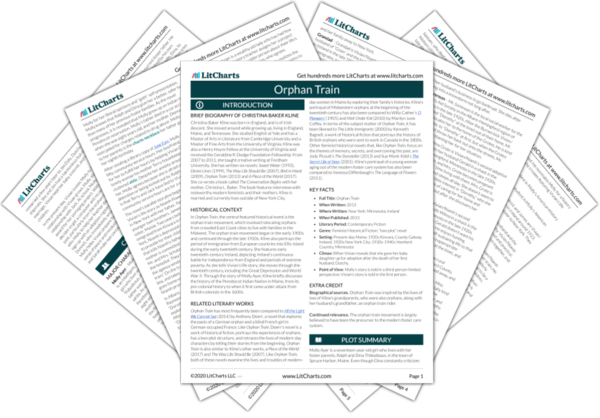Belonging and Connection
Molly Ayer and Vivian Daly, two women born in different places and eras and who were orphaned as young children, both struggle to find a sense of home and belonging. Because of the loss and betrayal they have suffered, they each find it difficult to open their hearts to new people. Ultimately, however, the two women form a friendship through storytelling and mutual acts of care and acceptance. Even though they both lack a…
read analysis of Belonging and ConnectionSelf and Identity
Both Vivian and Molly struggle to maintain and define their identities in the face of changing, unreliable, and even hostile environments. Both protagonists come into foster or adoptive care at a young age—before their identities and personalities have been fully formed—and both struggle to develop and define their identities in situations in which they do not feel the love and acceptance that would allow them to express themselves in authentic ways. Compounding this, both women…
read analysis of Self and IdentitySafety and Survival
As children, Molly and Vivian both become responsible for their own survival, and they struggle to find a place in which they feel safe physically and emotionally. Their safety is often threatened, making them vulnerable to exploitation and abuse—and even when their safety isn’t immediately threatened, their status as orphaned children makes them vulnerable to the whims of strangers, which prevents them from ever feeling truly safe. Their struggle makes them strong and resourceful, but…
read analysis of Safety and Survival
Trauma and Loss
The novel is riddled with traumatic events and losses that are beyond Molly and Vivian’s control. These events shape their outlook and their sense of the world, and impair their ability to feel safe and connected to others. Yet, as both Molly and Vivian learn, it is necessary to recover from and process trauma in order to fully reconcile with oneself, move forward in life, and develop new attachments and connections.
Both Molly and…
read analysis of Trauma and LossSecrets, Reality, and Illusions
Within the novel, appearances are often deceiving. Over time, this creates illusions about reality that can have detrimental consequences for the vulnerable protagonists. At the same time, secrets and pretenses may also help to aid vulnerable people in their survival. Ultimately, Vivian and Molly discover that liberation from secrets and illusions is part of the process of reconciling with past mistakes and trauma in order to move forward.
As Vivian and Molly discover, misleading appearances…
read analysis of Secrets, Reality, and IllusionsHope and Skepticism
In the aftermath of traumatic events and devastating losses, Molly and Vivian struggle to hold onto a sense of hope. In its place, they often feel disillusionment and skepticism, particularly towards other people and human relationships in general. Ultimately, however, they discover that hope is a prerequisite to feeling connected to others—and connection, they learn, is what gives life meaning.
As Molly and Vivian demonstrate, skepticism makes risky emotional situations more palatable. Rather than expecting…
read analysis of Hope and Skepticism






